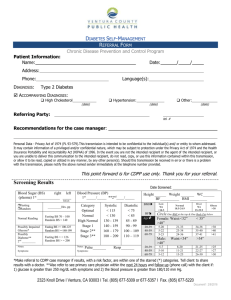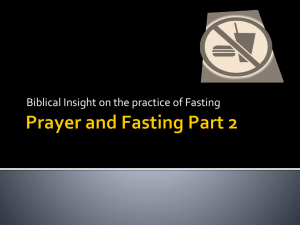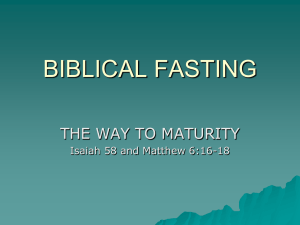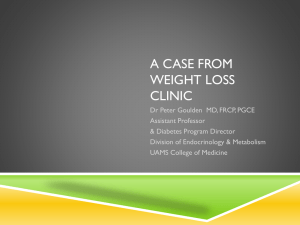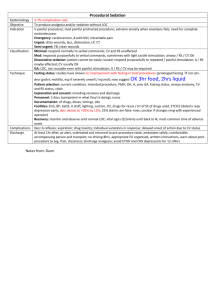Islamic fasting Fasting and Multiple Sclerosis
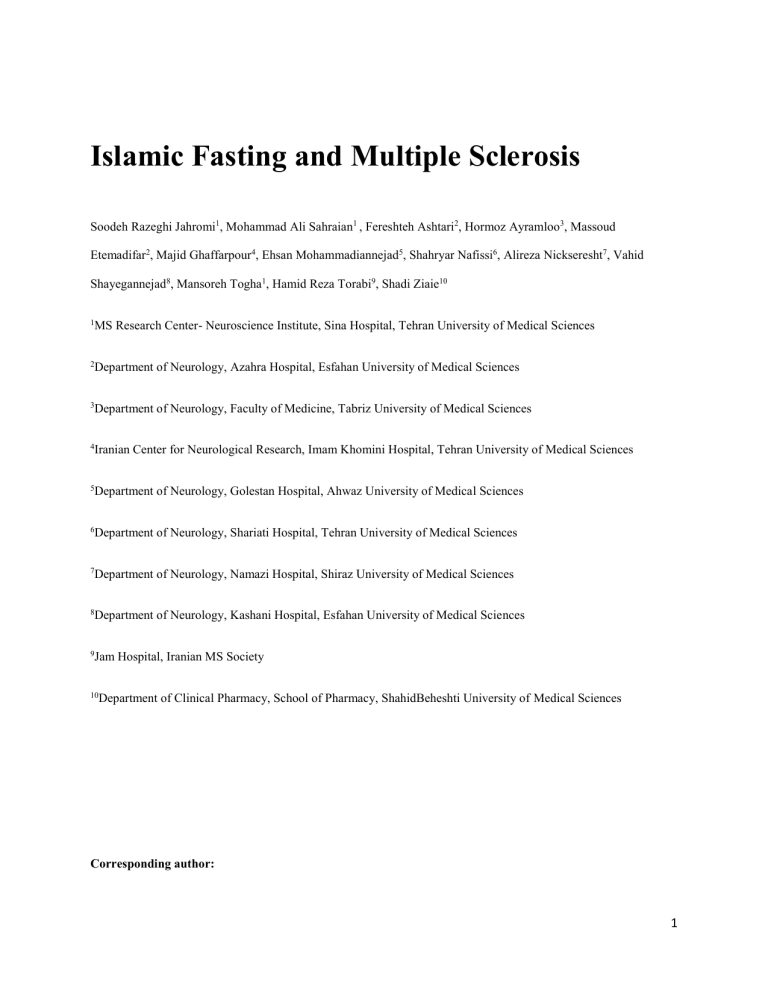
Islamic Fasting and Multiple Sclerosis
Soodeh Razeghi Jahromi 1 , Mohammad Ali Sahraian 1 , Fereshteh Ashtari 2 , Hormoz Ayramloo 3 , Massoud
Etemadifar 2 , Majid Ghaffarpour 4 , Ehsan Mohammadiannejad 5 , Shahryar Nafissi 6 , Alireza Nickseresht 7 , Vahid
Shayegannejad 8 , Mansoreh Togha 1 , Hamid Reza Torabi 9 , Shadi Ziaie 10
1 MS Research Center- Neuroscience Institute, Sina Hospital, Tehran University of Medical Sciences
2 Department of Neurology, Azahra Hospital, Esfahan University of Medical Sciences
3 Department of Neurology, Faculty of Medicine, Tabriz University of Medical Sciences
4 Iranian Center for Neurological Research, Imam Khomini Hospital, Tehran University of Medical Sciences
5 Department of Neurology, Golestan Hospital, Ahwaz University of Medical Sciences
6 Department of Neurology, Shariati Hospital, Tehran University of Medical Sciences
7 Department of Neurology, Namazi Hospital, Shiraz University of Medical Sciences
8 Department of Neurology, Kashani Hospital, Esfahan University of Medical Sciences
9 Jam Hospital, Iranian MS Society
10 Department of Clinical Pharmacy, School of Pharmacy, ShahidBeheshti University of Medical Sciences
Corresponding author:
1
Mohammad Ali Sahraian, MD
MS Research Center, Neuroscience Institute, Sina Hospital, HasanAbad Square, Tehran, Iran
Tel: +98 21 66348571
Fax: +98 21 66348570
Email: msahrai@sina.tums.ac.ir
2
Abstract
Background: Month-long daytime Ramadan fasting posesmajor challenges to multiple sclerosis (MS) patients in
Muslim countries. Physicians should have practical knowledge on the implications of fasting on MS. We present a summary of database searches (Cochrane Database of Systematic Reviews, PubMed) and a mini-symposium on
Ramadan fasting and MS. In this symposium, we aimed to review the effect of fasting on MS and suggest practical guidelines on management.
Methods: Information regarding Ramadan fasting and MS was obtained through Cochrane and PubMed databases.
Relevant abstracted reports were considered from initiation of these databases to June 2013. The results of the minisymposium were recorded.
Discussion: In general, fasting is possible for most stable patients. Appropriate amendment of drug regimens, careful monitoring of symptoms, as well as providing patients with available evidence on fasting and MS are important parts of management. Evidence from experimental studies suggests that calorie restriction before disease induction reduces inflammation and subsequent demyelination and attenuates disease severity. Fasting does not appear to have unfavorable effects on disease course in patients with mild disability (Expanded Disability Status Scale (EDSS) score ≤3). Most experts believed that during fasting (especially in summer), some MS symptoms (fatigue, fatigue perception, dizziness, spasticity, cognitive problems, weakness, vision, balance, gait) might worsen but return to normal levels during feasting. There was a general consensus that fasting is not safe for patients: on high doses of anti-convulsants, anti-spastics, and corticosteroids;with coagulopathy or active disease; during attacks;with
EDSSscore ≥7.
Conclusion: These data suggest that MS patients should have tailored care. Fasting in MS patients is a challenge that is directly associated with the spiritual belief of the patient.
Keywords : Ramadan fasting, multiple sclerosis, calorie restriction,
3
Introduction
Several religions mention periods of fasting in their respective holy books. A demographic study in 2009 reported that 23% (1.57 billion) of the world population is Muslim [1]. This percentage is growing by
3% per year. Fasting during the holy month of Ramadan is considered to be one of the five pillars of Islam.During Ramadan, Muslims are forbidden from eating, drinking, smoking, and sexual congress from dusk to dawn. Travelers, women who are menstruating, pregnantor lactating,children as well asthe sick and disabled are exempt from fasting [2]. However, many Muslims who are eligible for exemption (including individuals with mild, moderate, and severe medical conditions) choose to fast. Moreover, recent evidencesuggests that there is no contraindication to Islamic fasting for patients with mild coronary artery disease, valvular problems, stable asthma, type-2 diabetes mellitus (T2DM), asymptomatic peptic ulcers, and intestinal motility disorders. Consequently, Muslim patients with various medical disorders are seeking advice about the safety and feasibility of fasting[3].
Multiple sclerosis (MS) is one of these medical conditions. MS is a chronic demyelinating disease with an unclear etiology.It affects
2.5 million individuals worldwide and has been identified as the most common debilitating neurological disease in young adults[4]. MS is an immune-mediated inflammatory disease of the central nervous system (CNS) that, in the most severe cases, can lead to irreversible disability[5].
The concern for Muslim MS patients is whether Ramadan fasting might have an unfavorable effect on disease course. This debate became more heated after the work of Esquifino et al. on the animal model of MS:experimental autoimmune encephalomyelitis (EAE). In studies in humans and animals, the effect of fasting on health is commonly studied in three forms: calorie restriction (CR), alternate-day fasting (ADF) and dietary restriction. ADF and CR can induce similar changes upon metabolism and physiology. Esquifino et al. reported that CR improves signs of EAE[6]. Hence, we reviewedthe opinions of neurologists involved in the care of MS patients with regard tothe clinical impact of Ramadan fasting on MS irrespective of their religious beliefs.
For this purpose, we first reviewed current evidenceregarding fasting and MS. Second, we prepared a concise summary of the points discussed in a mini-symposium on the effect of fasting on MS patients. In this symposium, we asked neurologists, nutritionists, and pharmacists to present a summary of available evidence as well as their clinical experiences of fasting and MS. Consequently, we aimed to provide practical guidance for MS patients who
4
wished to fast with respect to general health, disability score, level of activity, sex, weight, symptoms and employment.
5
Materials and methods
Information regarding Ramadan fasting and MS was obtained through the Cochrane Database of Systematic
Reviewsand PubMed databases. Relevant abstracted reports were considered from initiation of these databases to
June 2013by combining the term “Ramadan” (476 entries) with terms specific to each of the topics under investigation. All relevant abstractson a “ketogenic diet” (703 items) as well as “calorie restriction” or “fasting” combined with the terms “neuroprotection” and” immunity” (38 items) were reviewed. The results of the minisymposium were recorded.
Results and Discussion
Fasting in animal studies
CR with nutritional maintenance has been proposed to extend lifespan in fruit fly, nematodes, zebra fish, spiders, rodents, and rotifers [7]. In addition to slowing the aging process, CR has been demonstrated to delay the onset of atherosclerosis, cardiomyopathies, renal disease, T2DM, cancers, and respiratory disease [7].
6
With regard to neurological diseases and fasting,CR represents the first effective treatment for epilepsy in medical history [8]. CR results in an increase in the serum level of the ketone body
-hydroxybutyrate. This rise in
hydroxybutyrate level correlates with a significant reduction in the vulnerability of hippocampal neurons to injection of the mineral salt kainite. In the 1920s, the ketogenic characteristics of CR led to the development of the high-fat, low-carbohydrate ketogenic diet (KD) [8]. The antiepileptic properties of KD could be explained (at least in part)by its anti-apoptotic and antioxidative properties. Recent studies suggested that the pro-apoptotic proteinnuclear clusterindid not accumulate in the hippocampi of KD-fed mice in which seizures were induced by kainic acid (KA)
[9]. KD also reduced KA-induced cell death in the hippocampus by reducing caspase-3 levels and blocking the dissociation of Bcl-2-associated death proteinfrom 14-3-3 proteins [10]. Noh et al. undertook an invitro study on the effect of acetoacetate (AA) on glutamate cytotoxicity in primary hippocampal neurons in rats and the mouse hippocampus cell line HT22. Pretreatment with AA reduced production of reactive oxygen species in the HT22 cell line. AA also decreased the appearance of propidiumiodine-positive and annexin V-positive HT22 cells, which are representative of necrosis and apoptosis, respectively [11].
Accumulating data suggest that the beneficial effects of CR are not limited to ketogenic properties. CR per se has profound neuroprotective effects in animal models relevant to the pathogenesis of neurodegenerative disorders such as Huntington disease, Parkinson disease, Alzheimer disease and stroke. Opalachet al. investigated the effect of 40% lifelong CR on age-related oxidative damagein peripheral nerves. They found that CR ameliorates the age-related accumulation of crosslinked and oxidized substances in peripheral nerves. CR also attenuated age-related increments in levels of nuclear factor kappaB (NF-κB), phospho-IkB, and tumor necrosis factor (TNF)-α[12]. Age-related oxidation of polyunsaturated fatty acids in myelin results in the formation of hydroxyalkenals and hydroperoxidases such as4-hydroxynonenal (HNE) and malondialdehyde (MDA), which react with proteins and change their surface hydrophobicity. CR suppresses age-related increases in the MDA-adducted proteins of sciatic nerves. CR also reduces HNE-positive areas throughout axonal and glial compartments [12]. Several other molecular and cellular mechanisms have also been proposed for the neuroprotective action of CR: decrease in the mitochondrial production of free radicals [13];promotion of antioxidant defense [8]; induction of bioenergetic compounds [8, 14]; elevation in the activity of sirtuin[15]; rise in the activity of neurotrophic factors [8]; increase in the activity of protein chaperones[8]; enhancement of neurogenesis [8]; imposition of anti-inflammatory properties; [8]; reduction in
7
leptin levels [16]; and reduction of the apoptosis of oligodendrocytes [7]. Each of these molecular and cellular mechanismsmake CR beneficial by protecting against MS and EAE.
Only three studies on CR in an animal model of MS (EAE) have been carried out. In two of these studies, Esquifino et al. found that restricting energy intake by 33% or 66% from 15 days before EAE inductiondecreaseddisease severity in rats [17–18]. Rats in the latter group were totally protected against EAE. Subjecting rats to 66% CR led to impaired proliferation of lymphocytes, reduction in the number of CD4+ cells in lymphoid organs, and suppressed production of interferon (IFN)-γ.In a study by Piccio et al., mice were subjected to 40% CR from 5 weeks before theinduction of disease. They observed comparable beneficial effects on disease course [19]. They found that CR worked through enhancement of the production of endogenous glucocorticoids but not through suppression of the immune system.In the three studies mentioned above, threeconcepts were proposed for the beneficial effects of CR.
Concept 1: improving immune function
Long-term CR improves T-cell function and delays immune senescence. According to a study by Squifino et al.,
66% CR results in modification of the 24-hrhythmicity of lymph nodes infected by tuberculosis, T cells, functions of
CD4+-CD8+ and CD4+ cell subsets, as well asmitogenic responses in lymph nodes to concanavalin A and lipopolysaccharide. Furthermore, mean values of the submaximal lymph-node response to concanavalin Aand number of CD4+ cellsincreased. Conversely, the number of B-cells and secretion of IFN-γ decreased[20]. In the study by Piccio et al., 40% CR ameliorated the signs of EAE without suppression of proliferation of Tcells. Longterm CR reduced susceptibility to infectious diseases by enhancing T-cell function [19]. Taken together, application ofCRbefore disease induction protects against EAE by improving T-cell function.
Concept 2: CR enhances glucocorticoid production
Glucocorticoids have inhibitory effects on the expression of genes associated with inflammation[21]. Systemic administration of corticosteroidsexacerbates MS [22]. In rodents, treatment with exogenous glucocorticoids blocks
EAE[23]. In the study by Piccio et al., 4-week CR increased corticosterone levels [19]. Interestingly, endogenous production of corticosteroneavoidsthe side-effects reported in the exogenous administration of corticosteroids[19].
Concept 3: imposition of animmunomodulatory effect
8
Interleukin 6 (IL)-6 can be produced by adipose tissue. Four weeks of CR has been shown to reduce body fat and, consequently, IL-6 levels. IL-6 has a critical role in EAE induction[19]. IL-6 together with transforming growth factor (TGF)-β has been reported to inhibit the production of T regulatory cells, and results in suppression of expression of T-helper (Th)-17 genes[19]. Expression of Th-17 is one of the main features of MS [24].
Fasting in human studies
There is limited evidence about fasting(especially Islamic fasting and MS). However, the immunomodulatory and antioxidative properties of fasting havebeen the subject of scientific investigations recently.
Ahmed T et al. undertook a study on 30% or 10% CR in 40 healthy overweight men and women over 6 weeks. They reported that delayed-type hypersensitivity responses(which reflect cell-mediated immunity) were increased significantly in both groups. Also, 30% CR reduced prostaglandin(PG)E2production and T-cell proliferative responses to anti-CD3. Moreover, they observed that proliferative T-cell responses to T-cell receptor antibodies and
T-cell mitogens were increased in both groups. They concluded that CR can also improve T-cell function in humans[25]. Paliet al. compared the immune function of 12 obese adolescents with healthy, normal-weight adolescents. They found that the IFN- γ/IL-4 ratio in CD4+ cells was higher in obese individuals. They proposed that the antigen presenting cell-regulatory T-cell–CD4+ lymphocyte axis might be affected by calorie disturbance
[26]. The effect of CR on humans has been studied in a randomized controlled trial sponsored by the USA National
Institute on Aging. Preliminary results showed that 20–25% CR for 6–12 months reduceslevels of leptin, T3 and fasting insulin. CR also reduces DNA damage as a marker of oxidative insult [27]. Fraser et al. conductedstudies on the effect of fasting on patients with rheumatoid arthritis. Rheumatoid arthritis is an autoimmune disease that shares immunological features with MS. They reported that 7-day fasting reduced the activity of CD4+ lymphocytesand induced IL-4 production [28]. Latifynia et al. assessed the effect of Ramadan fasting on innate immunity
(tetrazolium reaction in neutrophils and opsonization of phagocytes). They concluded that the innate immune response increases after fasting [29].
Fasting and MS
Only two studies on Ramadan fasting in MS patients have been carried out. El-Dayem and Zytoncarried out a study on 30 MS patients aged 15–45 years with anExpanded Disability Status Scale(EDSS) score <3. After 1 year, no
9
significant differences were observed in relapse rate, EDSS score, and gadolinium-enhanced lesions on MRI between fasted and non-fasted groups [30]. Saadatnia et al. undertook a study on 80 patients aged >17 years with an
EDSS score ≤3. After 6 months, no significant differences in EDSS score or frequency of clinical relapses were noted between fasted and non-fasted groups. El-Dayem and Zytonconcluded that fasting does not have unfavorable effects in the short term. The authors also stated thatreduction of food intake (especially of fat) during Ramadan could enhance antioxidative activity and consequently protect against relapse after Ramadan. El-Dayem and
Zytonalso suggested that reduction of levels of uric acid during Ramadan fasting could protect against MS relapse.
Uric acid is formed as a metabolite of purineand is concentrated following dehydration during fasting. Serum levels of uric acid are lower in MS patients comparedwith healthy individuals [31].
In the section below, we present evidence (in the form of questions)from points discussed in the mini-symposium described at the start of this article.
Question 1: Is it safe for MS patients to fast?
The effect of fasting on MS is not clearbut Islamic fasting is, in general, considered to be safe in most MS patients.
However, making a general recommendation about the safety of fasting in MS patients is not possible. The decision should be made with respect to individual conditions. Ramadan fasting does not appear to have negative effects on
MS patients with mild disability in the short term [30–31]. Patients should be monitored for individual symptoms
(e.g., fatigue, energy level), type of MS, level of disability, systemic disease, medications takenas well as social skills. Patient education is an important part of management:they should be informed about the symptoms associated with exacerbation of MS.
Question 2: Does fasting affect MS symptoms?
One of the main concerns is whether fasting affects MS symptoms. Authors have reported no short-term unfavorable effects of fasting on disease course [30–31].However,it is believed that during fasting, some of the symptoms of MS might worsenbut return to usual levels during feasting. Symptoms include: fatigue, dizziness, spasticity, cognitive problems, weakness, vision, balance, and gait.
10
Studies in healthy adults have revealed fasting to induce fatigue as well as the perception of fatigue. In a study carried out to assess the effect of Ramadan fasting on muscle power and fatigue in healthy football players after 2 weeks and 4 weeks of fasting, muscle power was decreased and fatigue increased in the evening. Moreover, the perception of exertion and fatigue is higher during Ramadan [32]. It seems that perceived fatigue is less common in
MS patients who spiritually believe in fasting. However, in patients who believe fasting to be an obligation, perceived fatigue might be more prevalent. Moreover, heavy workers complain about tiredness and dizziness during
Ramadan fasting, which may be due to dehydration [33].
Studies suggest that fasting has no effect on the vision of healthy adults. In healthy, middle-aged volunteers, fasting does not affect values of intraocular pressure, refractive error or visual activity [34]. However, it is believed that, unlike healthy adults, fasting might affect vision in MS patients.In a study on judo athletes, Ramadan fasting had negative effects on postural control:unipodaland bipodal sway velocity was decreased [35].
Studies on the effects of Ramadan fasting on the mood profile have elicited mixed results. In a study on eight middle-distance runners, a 30-day fast negatively affectedthe mood profile [36]. In another study on 20 young football players, the mood profile did not show significant differences during and after Ramadan compared withbefore Ramadan [37].
In another study on healthy athletes, changes in cognitive function were studied during Ramadan. The cognition domains werepsychomotor functions, vigilance, visual learning, verbal learning, memory, and executive function.
Comparison of cognitive function in the morning with the afternoon showed a significant decline in psychomotor function, visual and verbal learning, and memory. The extent of the effect was greater during Ramadan [38].
Question 3: Does fasting affect MS exacerbation?
Studies suggest that Ramadan fasting neither protects nor provokes MS attacks. However, more prospective studies are needed to follow clinical conditions after Ramadan.
Question 4: Can symptomatic treatments be taken during fasting?
11
One of the other most frequently asked questions about fasting in MS patients is whether symptomatic treatments are possible during fasting. It is believed that, for some drugs, amending the drug regimen is possible during
Ramadan by substituting oral agents with injections, or by prescribing slow-release or long-acting drugs once or twice at night. However, accurate distribution of drugs prescribed twice a day or three times a day between the morning meal (Suhoor) and evening meal (Iftar) is difficult. If dosing and the time span between doses are changed, these alterations might affectthe serum level of the drug and, consequently, its tolerability and efficacy [3].
Furthermore, drug–food interactions can result in delayed, reduced or increased bioavailability of a drug. Also, changes in circadian rhythms, sleep disturbances, emotional stress and physical stress can influence drug pharmacokinetics. In one study, even changingthe timing of a single dose of valproate (800 mg) during Ramadan increased the frequency of seizures significantly [39]. The problem becomes more notable in patients on polytherapy. Table 1 summarizescircadian variations in the pharmacodynamics and pharmacokinetics of commonly prescribed medicationsfor MS, as well as their drug–food interactions.
It is believed that fasting is not feasible for patients on high doses of anti-spastic drugs or antiepileptic drugs as well as patients takingdrugs more than twice a day. Similarly,fasting should be avoided if changing the drug has negative effects on the activities of daily living or level of disability. There is also a general consensus that amending the drug regimen should be started before Ramadan. In a study on 114 epileptic patients, amending the drug regimen according to the timing of Suhoor and Iftar did not prevent an increase in seizure frequency [40].
Question 5: Candisease-modifying drugsbe consumed during fasting?
The pharmacokinetics and pharmacodynamics of interferons and glatiramer acetate are not affected by food consumption.Also, it seems that the plasma drug concentration–time curve of interferons and glatiramer acetate are not affected by prolonged fasting [41–42]. Data on the effect of fasting on the pharmacokinetics and pharmacodynamics of fingolimod are not available. However, according to some neurologists,fasting is not recommended for patients who experience severe flu-like symptoms (fever, chills, sweating, muscle aches, fatigue) after injection of interferons and glatiramer acetate.
Fasting might affect the pharmacokinetics and pharmacodynamics of immunosuppressants. Also, drug–food interactions may result in the increased/reduced/delayed systemic availability of immunosuppressants. Table 2
12
details the effects of fasting on the pharmacokinetics and pharmacodynamics of immunosuppressants and manufacturer recommendations for their consumption [43]. Pharmacokinetic and pharmacodynamic reactions between cyclophosphamide and foods have not been reported. However, cyclophosphamide is excreted mainly in the urine, so limited access to liquids during fasting may have negative effects on drug levels [44].
Question 6: Is the level of disability (EDSS score) important if a patient decides to fast?
As mentioned above for the data ofSaadatnia et al. and El-Dayem, fasting is known to be safe in patients with mild disability (EDSS score ≤3). Patients with higher levels of disability are less physically active.Consequently, they are more prone to constipation, infection of the upper urinary tract, bedsore, and diverticulitis. Dehydration during prolonged fasting could aggravate such symptoms. It is recommended that patients with anEDSS score ≥7 avoid fasting.
Question 7: Does the type of MS interfere with the decisionto fast?
It is believed that, regardless of the type of MS, patients with highly active disease should be prohibited from fasting. Also patients who experience attacks during or after Ramadan fasting should avoid fasting. During attacks, because ofthe high dose of corticosteroid therapy, fasting is not recommended.
Question 8:Is fasting during summer safe for MS patients?
The demands of fasting at high latitudes during winter are different from those in equatorial regions during summer
[45]. Increasing the number of fasting hours during summercan increase the negative effects of fasting.
Individualized monitoring of MS patients who observe fasting during summer and avoiding dehydration is recommended.
Question 9: Is it safe for MS patients to fast for a whole month?
The interval between fasting days should be tailored to the condition of the patient. Appropriate sleep, adequate and appropriate intake of food and fluidsduring feasting hours are recommended. According to Saadatnia et al., fasting for 13 h a day for 28 days does not result in unfavorable short-term effects [31].
13
Conclusions
Fasting during Ramadan is an obligation for healthy Muslim adults. Studies on fasting in MS patients(especially
Islamic fasting) are very rare andhave focused on the protective role of intermittent fasting in MS patients. There is insufficient evidenceto suggest fasting can protect against or control MS signs, butfasting does not have unfavorable effects on disease course.
In the mini-symposium discussed above, there is a general consensus that observation of Ramadan fasting is possible for many MS patients. Careful monitoring of general and clinical conditionsas well as precise management of drug regimens, diet, and sleep patternswill help to reduce the potential negative effects of fasting. However, fasting is not recommendedduring attacks, in patients on high doses of anti-spastic and anti-convulsant drugs,or in those with coagulopathy,anEDSS score ≥7, oractive disease.
Fasting (especially during summer) might negatively affect fatigue, weakness, vision, balance, and gait.Individualized recommendations should be made with respect to energy level and general wellbeing. It seems that MS patients who believe in fasting as a sacred obligation report fewer negative impacts of fasting on MS signs.
For example, perceived fatigue is increased during fasting. Spiritual belief might reduce the perception of fatigue.
This hypothesis might be expandable to other symptoms of the disease. Conversely, in patients who find themselves obliged to fast, the perception of the negative impacts of fasting might be greater. Patients should be provided with scientific evidence about the effects of fasting on health issues before Ramadan to make informed decisions about fasting.
More studies are needed to prepare detailed guidelines for MS patients. Our database search and mini-symposium meeting were attempts to help physicians for the better care of MS patients who decide to fast, as well as to pave the way for more research in this field.
Abbreviations
AA: acetoacetate
ADF: alternate-day fasting
14
CNS: central nervous system
CR: calorie restriction
EAE: experimental autoimmune encephalomyelitis
EDSS: Expanded Disability Status Scale
HNE: 4-hydroxynonenal
KD: ketogenic diet
IFN-γ: interferon-gamma
IL-6: interleukin-6
MDA: malondialdehyde
MS:multiple sclerosis
NF-κB: nuclear factor kappaB
Th-17: T-helper 17
TGF-β: transforming growth factor beta
TNF-α: tumor necrosis factor-α
Competing interests
None of the authors had any financial or personal conflicts of interest.
Author contributions
SRJ: Wrote the primary draft.
MAS: Proposed the idea, managed the meeting, and revised the primary draft.
15
HA: Active participation in the meeting, reviewing the literature and approving the primary draft
ME: Active participation in the meeting, reviewing the literature and approving the primary draft
MG: Active participation in the meeting, reviewing the literature and approving the primary draft
EM: Active participation in the meeting, reviewing the literature and approving the primary draft
SN: Active participation in the meeting, reviewing the literature and approving the primary draft
AN: Active participation in the meeting, reviewing the literature and approving the primary draft
VS: Active participation in the meeting, reviewing the literature and approving the primary draft
MT: Active participation in the meeting, reviewing the literature and approving the primary draft
HRT: Active participation in the meeting, reviewing the literature and approving the primary draft
SZ: Active participation in the meeting, reviewing the literature and approving the primary draft
Acknowledgments
The meeting and accommodations weresupported by an unrestricted educational grant from CinnaGen Company.
The authors thank the sponsor for logistic support during the meeting and also thank the Research Development
Center of SinaHospital for language editing of the manuscript.
16
References
1.
2.
3.
4.
5.
6.
Al-Arouj M, Assaad-Khalil S, Buse J, Fahdil I, Fahmy M, Hafez S, Hassanein M, Ibrahim MA,
Kendall D, Kishawi S: Recommendations for management of diabetes during Ramadan update
2010.Diabetes Care 2010, 33:1895-1902.
Azizi F: Islamic fasting and health.Annals of Nutrition and Metabolism 2010, 56:273-282.
Beshyah SA, Fathalla W, Saleh A, Al-Kaddour A, Noshi M, Al Hatheethi H, Al-Saadawi N, Elsiesi H,
Amir N, Almarzouqi M: Ramadan Fasting and The Medical Patient: An Overview for
Clinicians.Ibnosina Journal of Medicine and Biomedical Sciences 2010, 2:240-257.
MS? NmssAMWg: http://wwwnationalmssocietyorg/about-multiple-sclerosis/what-we-know-
about-ms/who-gets-ms/indexaspx 2011.
Wingerchuk DM, Lucchinetti CF, Noseworthy JH: Multiple sclerosis: current pathophysiological
concepts.Lab Invest 2001, 81:263-281.
Esquifino AI, Cano P, Jimenez V, Cutrera RA, Cardinali DP: Experimental allergic
encephalomyelitis in male Lewis rats subjected to calorie restriction.J PhysiolBiochem2004,
60:245-252.
7.
8.
9.
Maalouf M, Rho JM, Mattson MP: The neuroprotective properties of calorie restriction, the
ketogenic diet, and ketone bodies.Brain research reviews 2009, 59:293-315.
Maalouf M, Rho JM, Mattson MP: The neuroprotective properties of calorie restriction, the
ketogenic diet, and ketone bodies.Brain research reviews 2009, 59:293-315.
Noh HS, Kim DW, Kang SS, Cho GJ, Choi WS: Ketogenic diet prevents clusterin accumulation
induced by kainic acid in the hippocampus of male ICR mice.Brain research 2005, 1042:114-
118.
10. Noh HS, Kim YS, Kim YH, Han JY, Park CH, Kang AK, Shin HS, Kang SS, Cho GJ, Choi WS: Ketogenic diet protects the hippocampus from kainic acid toxicity by inhibiting the dissociation of bad
from 14‐3‐3.Journal of neuroscience research 2006, 84:1829-1836.
17
11. Noh HS, Hah YS, Nilufar R, Han J, Bong JH, Kang SS, Cho GJ, Choi WS: Acetoacetate protects
neuronal cells from oxidative glutamate toxicity.Journal of neuroscience research 2006, 83:702-
709.
12. Opalach K, Rangaraju S, Madorsky I, Leeuwenburgh C, Notterpek L: Lifelong calorie restriction
alleviates age-related oxidative damage in peripheral nerves.Rejuvenation research 2010,
13:65-74.
13. Cheng CM, Hicks K, Wang J, Eagles DA, Bondy CA: Caloric restriction augments brain glutamic
acid decarboxylase‐65 and‐67 expression.Journal of neuroscience research 2004, 77:270-276.
14. Swerdlow RH: Treating neurodegeneration by modifying mitochondria: potential solutions to a
“complex” problem.Antioxidants & redox signaling 2007, 9:1591-1604.
15. Guarente L: Calorie restriction and sirtuins revisited.Genes & development 2013, 27:2072-2085.
16. Rogozina OP, Bonorden MJ, Seppanen CN, Grande JP, Cleary MP: Effect of chronic and intermittent calorie restriction on serum adiponectin and leptin and mammary
tumorigenesis.Cancer Prevention Research 2011, 4:568-581.
17. Esquifino A, Cano P, Jimenez V, Cutrera R, Cardinali D: Experimental allergic encephalomyelitis
in male Lewis rats subjected to calorie restriction.Journal of physiology and biochemistry 2004,
60:245-252.
18. Esquifino AI, Cano P, Jimenez-Ortega V, Fernández-Mateos MP, Cardinali DP: Immune response
after experimental allergic encephalomyelitis in rats subjected to calorie restriction.J
Neuroinflammation2007, 4:6.
19. Piccio L, Stark JL, Cross AH: Chronic calorie restriction attenuates experimental autoimmune
encephalomyelitis.J LeukocBiol2008, 84:940-948.
20. Esquifino AI, Cano P, Jimenez-Ortega V, Fernandez-Mateos MP, Cardinali DP: Immune response
after experimental allergic encephalomyelitis in rats subjected to calorie restriction.J
Neuroinflammation2007, 4:6.
21. Adcock IM, Caramori G: Cross-talk between pro-inflammatory transcription factors and
glucocorticoids.Immunology and Cell Biology 2001, 79:376-384.
22. Myhr K, Mellgren S: Corticosteroids in the treatment of multiple
sclerosis.ActaneurologicaScandinavica2009, 120:73-80.
23. Bolton C, O’Neill J, Allen S, Baker D: Regulation of chronic relapsing experimental allergic
encephalomyelitis by endogenous and exogenous glucocorticoids.International archives of
allergy and immunology 1997, 114:74-80.
24. Du C, Liu C, Kang J, Zhao G, Ye Z, Huang S, Li Z, Wu Z, Pei G: MicroRNA miR-326 regulates TH-17
differentiation and is associated with the pathogenesis of multiple sclerosis.Nature
immunology 2009, 10:1252-1259.
25. Ahmed T, Das SK, Golden JK, Saltzman E, Roberts SB, Meydani SN: Calorie Restriction Enhances
T-Cell–Mediated Immune Response in Adult Overweight Men and Women.The Journals of
Gerontology Series A: Biological Sciences and Medical Sciences 2009, 64:1107-1113.
26. Pali A, Paszthy B: Changes of the immune functions in patients with eating
disorders].Ideggyógyászatiszemle2008, 61:381.
27. Fontana L, Coleman R, Holloszy J, Weindruch R: Calorie restriction in non-human and human
primates.HANDBOOK OF THE BIOLOGY OF AGING 2010.
28. Fraser D, Thoen J, Reseland J, Førre Ø, Kjeldsen-Kragh J: Decreased CD4+ lymphocyte activation and increased interleukin-4 production in peripheral blood of rheumatoid arthritis patients
after acute starvation.Clinical rheumatology 1999, 18:394-401.
29. Latifynia A, Vojgani M, Gharagozlou M, Sharifian R: Neutrophil function (innate immunity)
during Ramadan.Journal of Ayub Medical College, Abbottabad: JAMC 2008, 21:111-115.
18
30. Abd El-Dayem SMA, Zyton HAH: The Effect of Ramadan Fasting on Multiple Sclerosis.Egyptian
Journal of Neurology, Psychiatry & Neurosurgery 2012, 49.
31. Saadatnia M, Etemadifar M, Fatehi F, Ashtari F, Shaygannejad V, Chitsaz A, Maghzi AH: Short-
term effects of prolonged fasting on multiple sclerosis.European neurology 2009, 61:230-232.
32. Chtourou H, Hammouda O, Chaouachi A, Chamari K, Souissi N: The effect of time-of-day and
Ramadan fasting on anaerobic performances.International journal of sports medicine 2012,
33:142.
33. Schmahl F, Metzler B: The health risks of occupational stress in islamic industrial workers
during the Ramadan fasting period.Polish journal of occupational medicine and environmental
health 1991, 4:219.
34. Assadi M, Akrami A, Beikzadeh F, Seyedabadi M, Nabipour I, Larijani B, Afarid M, Seidali E:
Impact of Ramadan fasting on intraocular pressure, visual acuity and refractive
errors.Singapore medical journal 2011, 52:263-266.
35. Souissi N, Chtourou H, Zouita A, Dziri C, Souissi N: Effects of Ramadan intermittent fasting on
postural control in judo athletes.Biological Rhythm Research 2013, 44:237-244.
36. Chennaoui M, Desgorces F, Drogou C, Boudjemaa B, Tomaszewski A, Depiesse F, Burnat P,
Chalabi H, Gomez-Merino D: Effects of Ramadan fasting on physical performance and
metabolic, hormonal, and inflammatory parameters in middle-distance runners.Applied
Physiology, Nutrition, and Metabolism 2009, 34:587-594.
37. Chtourou H, Hammouda O, Souissi H, Chamari K, Chaouachi A, Souissi N: The effect of Ramadan fasting on physical performances, mood state and perceived exertion in young
footballers.Asian Journal of Sports Medicine 2011, 2.
38. Tian H-H, Aziz A-R, Png W, Wahid M, Yeo D, Png A-L: Effects of fasting during Ramadan month
on cognitive function in Muslim athletes.Asian Journal of Sports Medicine 2011, 2.
39. Aadil N, Fassi-Fihri A, Houti I, Benaji B, Ouhakki M, Kotbi S, Diquet B, Hakkou F: Influence of
Ramadan on the pharmacokinetics of a single oral dose of valproic acid administered at two
different times.Methods Find ExpClinPharmacol2000, 22:109-114.
40. Gomceli YB, Kutlu G, Cavdar L, Inan LE: Does the seizure frequency increase in
Ramadan?Seizure 2008, 17:671-676.
41. Sturzebecher S, Maibauer R, Heuner A, Beckmann K, Aufdembrinke B: Pharmacodynamic
Comparison of Single Doses of IFN-beta 1a and IFN-beta 1b in Healthy Volunteers.Journal of
interferon & cytokine research 1999, 19:1257-1264.
42. Messina S, Patti F: The pharmacokinetics of glatiramer acetate for multiple sclerosis
treatment.Expert opinion on drug metabolism & toxicology 2013, 9:1349-1359.
43. Singh BN, Malhotra BK: Effects of food on the clinical pharmacokinetics of anticancer
agents.Clinical pharmacokinetics 2004, 43:1127-1156.
44. De Jonge ME, Huitema AD, Rodenhuis S, Beijnen JH: Clinical pharmacokinetics of
cyclophosphamide.Clinical pharmacokinetics 2005, 44:1135-1164.
45. Maughan RJ, Zerguini Y, Chalabi H, Dvorak J: Achieving optimum sports performance during
Ramadan: Some practical recommendations.Journal of Sports Sciences 2012, 30:S109-S117.
46. Singh BN: Effects of food on clinical pharmacokinetics.Clinical pharmacokinetics 1999, 37:213-
255.
47. Charman WN, Porter CJ, Mithani S, Dressman JB: Physicochemical and physiological
mechanisms for the effects of food on drug absorption: the role of lipids and pH.Journal of
pharmaceutical sciences 1997, 86:269-282.
48. Berry D, Millington C: Analysis of pregabalin at therapeutic concentrations in human
plasma/serum by reversed-phase HPLC.Therapeutic drug monitoring 2005, 27:451-456.
19
49. Shah J, Wesnes KA, Kovelesky RA, Henney III HR: Effects of food on the single-dose pharmacokinetics/pharmacodynamics of tizanidine capsules and tablets in healthy
volunteers.Clinical therapeutics 2006, 28:1308-1317.
50. Gidal BE, Maly MM, Kowalski JW, Rutecki PA, Pitterle ME, Cook DE: Gabapentin absorption:
effect of mixing with foods of varying macronutrient composition.The Annals of
pharmacotherapy 1998, 32:405-409.
20
Table 1: Circadian variations in pharmacodynamics and pharmacokinetics as well as drug–food interactions of commonly prescribed MS drugs
Drug
Baclofen
Food–drug interaction
No effect [46]
Dantrolene No effect [47]
Pregabalin
Tizanidine
Recommendation
Consuming with food decreased
C max by 25–30% and delayedt max by
3h [48]
Simultaneous food intake with a tizanidinecapsule reduced C max and
AUC o–t
by <20% and extendedt max from 0.75 h to 1.5 h.
In contrast,simultaneous food
Extent of absorption is increased ≤20% relative to administration of the tizanidine capsule under fasted conditions.
The dosage forms of the tablet and capsule were not consumption with a tizanidinetablet increased C max
and AUC o–t
by22.6% and 45.2%, respectively [49] bioequivalent if administered with food.
Food increasedthe t max
and the extent of absorption for the tablet and capsule. However, the C max values of tizanidine achieved if administered with food were increased by 30% for the tablet but decreased by 20% for the capsule. Under fed conditions, the capsule was
80% bioavailable relative to the tablet.
Gabapentin High-protein food increased the
AUC and C max by 26% and 32%,
Using tizaniidine together with caffeine is, in general, not recommended. Combining these medications may significantly increase the blood levels and effects of tizanidine.
Take extended release tablet with evening meal.
Swallow whole; do not chew, crush, or split.
21
respectively [50]
No significant effects on the rate or extent of absorption of the immediate-release tablet were noted.
The rate and extent of absorption of the extended-release tablet was increased.
Carbamazepi Serum levels of carbamazepine may Extended-release tablets should be administered with ne be increased if taken with food and/or grapefruit juice. meals; swallow whole, do not crush or chew.
SSRIs Paroxetine: peak concentration is increased, but bioavailability is not significantly altered by food
Sertraline: average peak serum levels may be increased if taken with food.
AUC o–t
, area under the curve from administration (0) to last observed concentration at (t), C max
, maximum concentration, t max
, time after administration of a drug when the maximum plasma concentration is reached
22
Table 2: Effect of fasting on the pharmacokinetics and pharmacodynamics of immunosuppressants and manufacturer recommendations for their consumption
Drug Manufacturer recommendations Circadian variations in pharmacodynamics and pharmacokinetics
Azathioprine
Cyclophosphamide
Methotrexate
Take after meals or in divided doses for reducing the risk of stomach upset
On an empty stomach with a glass of water or juice or with food
Tablets are not scored and should not be cut or crushed. Do not take tablets at bedtime to minimize the risk of bladder irritation.
Peak serum levels of On empty stomach with plenty of water. methotrexate may be decreased if taken with food.
Limit or avoid caffeine intake. Avoid drinks (e.g., coffee, tea, cola), foods (e.g., chocolate) or diet pills
Milk-rich foods may decrease that contain caffeine. methotrexate absorption.
23

